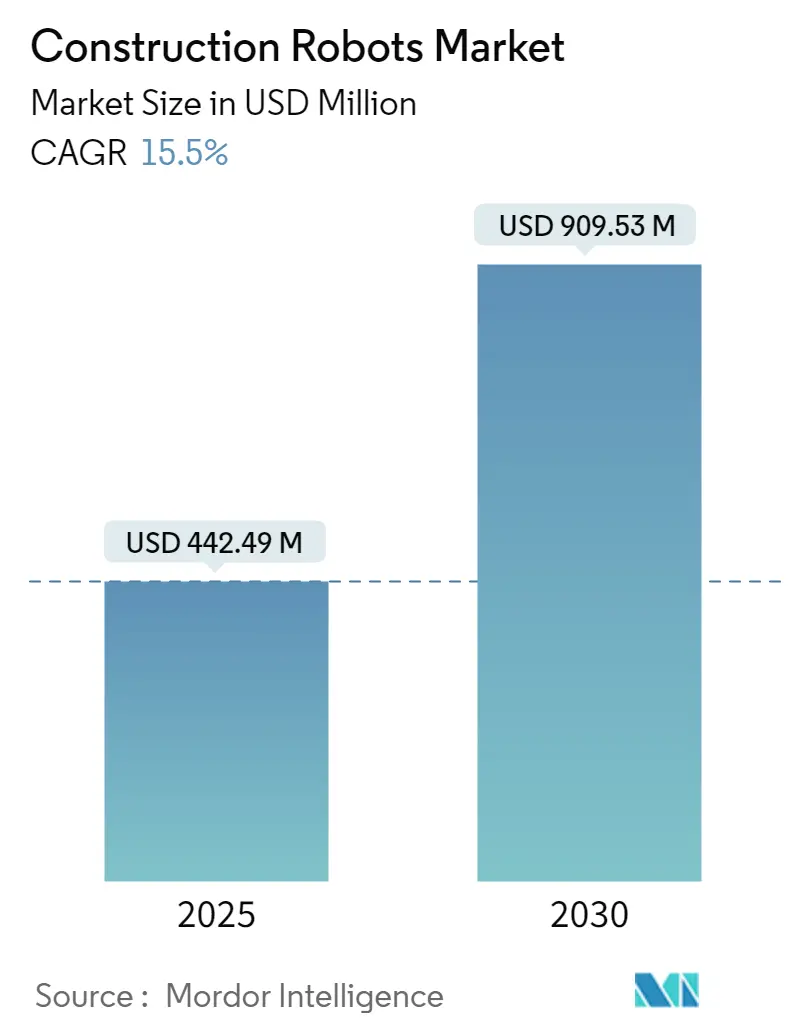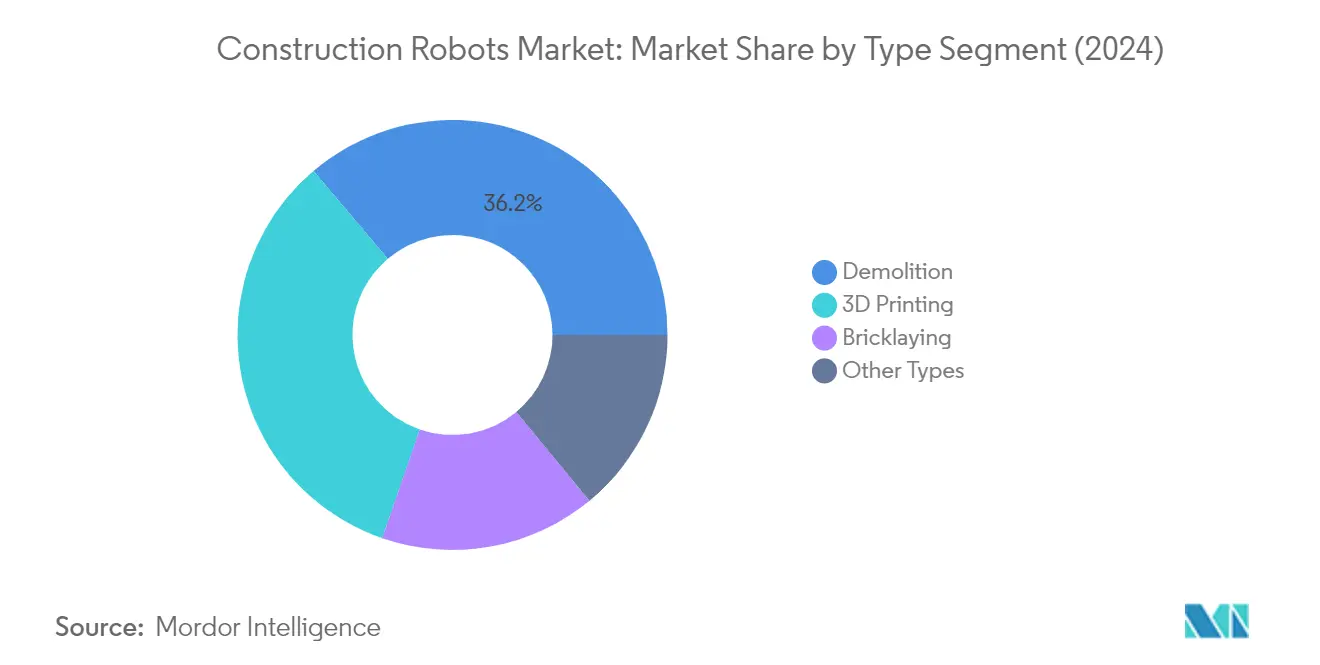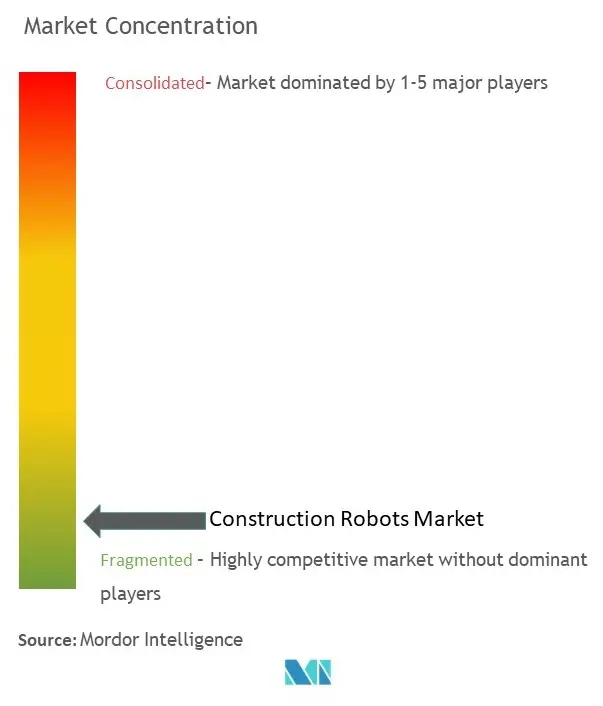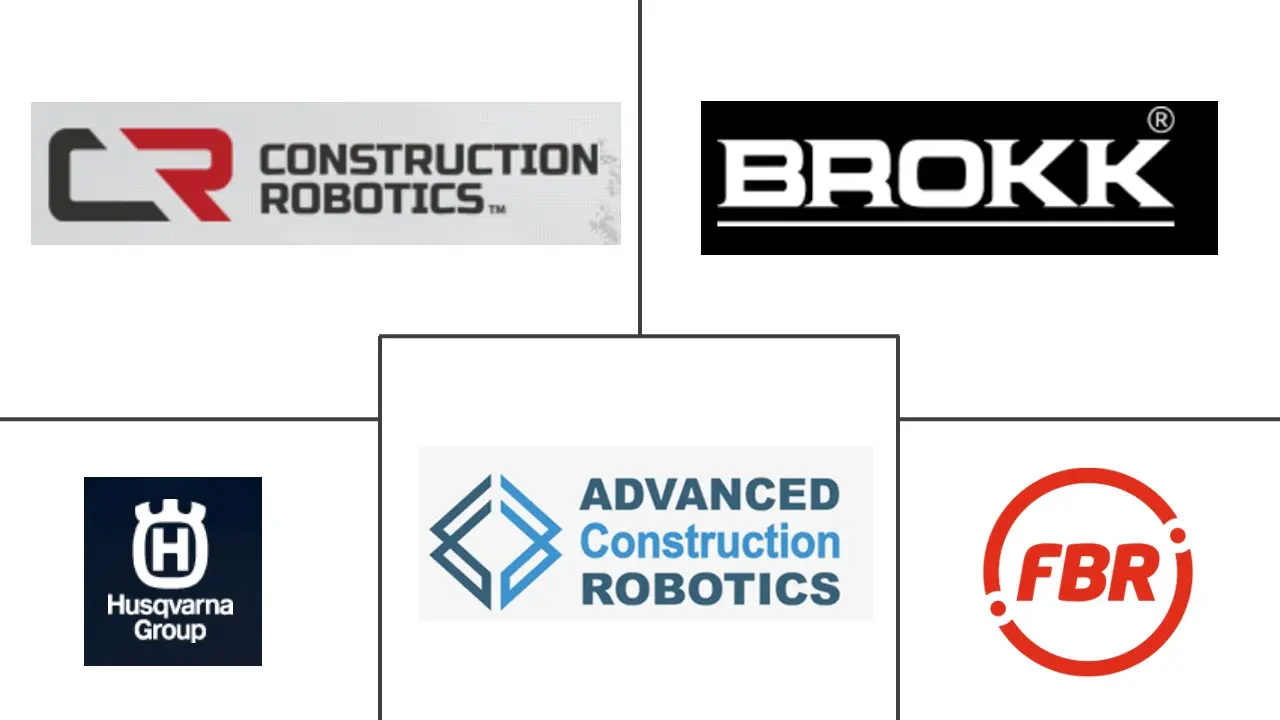
Construction Robots Market Analysis
The Construction Robots Market size is estimated at USD 442.49 million in 2025, and is expected to reach USD 909.53 million by 2030, at a CAGR of 15.5% during the forecast period (2025-2030).
The construction industry faces significant challenges related to resource efficiency and waste management, with studies from Autodesk revealing that approximately 30% of building materials transported to construction sites end up as waste. This inefficiency has prompted construction organizations to seek innovative solutions through construction robotics and automation. The U.S. Green Building Council has highlighted that building construction alone constitutes 30% of total waste in the United States, while global estimates range between 25-40%. The drive to reduce this wastage has shifted focus toward adopting construction robots, particularly in non-residential construction projects where precision and efficiency are paramount.
The industry is experiencing a severe labor shortage, with the Associated Builders and Contractors reporting that the construction sector will need an estimated 546,000 additional workers in 2023 to meet rising demand. This workforce challenge has accelerated the adoption of automated solutions, with construction companies increasingly turning to robots in the construction industry to bridge the labor gap. The industry averaged more than 390,000 job openings per month in 2022, representing the highest level on record, pushing contractors to explore innovative solutions through robotics in the construction industry technologies.
Significant technological advancements and investments are reshaping the construction landscape. In May 2022, Dusty Robotics secured USD 45 million in funding to develop advanced construction robotics solutions aimed at eliminating construction errors. Companies like Printstones have introduced multifunctional construction robotics capable of performing various tasks including material transportation, welding, milling, screwdriving, plasma cutting, painting, and bricklaying. These technological innovations are transforming traditional construction processes, improving efficiency, and reducing operational costs.
Looking ahead, the construction industry faces unprecedented demands, with projections indicating the need to construct approximately 13,000 buildings daily until 2050 to accommodate an expected urban population of seven billion. This massive scale of required construction is driving the industry toward more sustainable and efficient building practices. The integration of construction robotics and automation technologies is becoming increasingly critical for meeting these ambitious construction targets while maintaining quality standards and reducing environmental impact. The industry's focus has shifted toward developing more sophisticated robotic solutions that can handle complex construction tasks while minimizing resource wastage and improving overall project efficiency.
Construction Robots Market Trends
Rapid Urbanization
The unprecedented pace of global urbanization is creating an enormous demand for construction robotics and robots used in construction solutions. According to World Bank data, approximately 55% of the world's population, representing 4.2 billion people, currently reside in cities, with projections indicating this number will double by 2050 when nearly seven out of ten people worldwide will live in urban areas. This massive demographic shift is driving the need for rapid construction capabilities, with industry estimates suggesting that approximately 13,000 buildings must be constructed daily from now until 2050 to accommodate an anticipated urban population of seven billion people. The scale and urgency of this construction demand make traditional manual construction methods increasingly impractical, pushing the industry toward automated solutions.
The challenges of urbanization extend beyond just the volume of construction needed, as cities face increasing pressure to provide affordable housing and well-connected infrastructure systems. According to the World Bank, nearly one billion urban poor currently live in informal settlements, with 60% being forcibly displaced due to various urban conflicts and challenges. This situation has prompted major economies worldwide, particularly in North America and Europe, to explore innovative construction solutions that can deliver housing more efficiently and cost-effectively. Urban planning departments are specifically looking at robotics in construction, especially 3D printing solutions, as these technologies can significantly reduce building time while maintaining sustainability standards and helping to moderate housing prices for lower-income citizens.
Stringent Government Regulations for Worker Safety
The construction industry's high rate of workplace accidents and fatalities has led to increasingly stringent safety regulations worldwide, driving the adoption of construction robots for hazardous tasks. These regulations are particularly focused on confined spaces, such as crawl spaces, manholes, and tanks, which present significant risks including toxic substances, electrocutions, explosions, and asphyxiation. In response, regulatory frameworks like OSHA's Confined Spaces in Construction Final Rule and the Construction Design and Management (CDM) Regulation 2015 in the United Kingdom are mandating stricter safety protocols that can be effectively addressed through robotics deployment. These regulations are compelling construction companies to invest in automated solutions that can perform dangerous tasks while keeping human workers at a safe distance.
The implementation of these safety regulations has become more critical as construction activities become more complex and hazardous. Construction robots are increasingly being deployed for tasks such as demolition in nuclear facilities, handling hazardous materials, and working in extreme conditions where human safety would be at risk. For instance, in regions with strict worker protection laws, demolition robots are being used to handle asbestos removal and work in radioactive environments, allowing construction companies to comply with safety regulations while maintaining productivity. This regulatory environment, combined with the industry's growing awareness of worker safety, has created a strong impetus for the adoption of construction and robotics as a means to both comply with safety standards and protect worker well-being.
Segment Analysis: By Type
Demolition Segment in Construction Robots Market
The demolition segment continues to dominate the construction robots market, commanding approximately 36% market share in 2024. This significant market position is driven by rising public and private spending on rebuilding, restoration, and remodeling operations, which has resulted in increased demand for demolition robots. These robots have become essential tools in the construction industry due to their ability to work in hazardous environments and confined spaces where traditional demolition methods pose significant risks to human workers. The adoption of demolition robots has been particularly strong in urban renewal projects and infrastructure modernization initiatives, where precision and safety are paramount. Modern demolition robots incorporate advanced features like remote control capabilities, enhanced stability systems, and sophisticated end-of-arm tools that enable them to handle various demolition tasks efficiently while ensuring worker safety.

3D Printing Segment in Construction Robots Market
The 3D printing segment is emerging as the fastest-growing category in the construction robots market, with an expected growth rate of approximately 17% during 2024-2029. This remarkable growth is driven by increasing investments in automated construction solutions and the growing acceptance of 3D printing technology in the construction industry. The technology's ability to significantly reduce construction time, minimize material waste, and deliver complex architectural designs with precision has made it particularly attractive to construction companies and developers. Major construction firms are increasingly incorporating 3D printing robots into their operations, recognizing their potential to revolutionize traditional building methods. The segment's growth is further supported by advancements in printing materials, improved printing speeds, and the development of larger-scale printing capabilities that enable the construction of entire buildings.
Remaining Segments in Construction Robots Market by Type
The bricklaying and other specialized segments continue to play vital roles in shaping the construction robotics market. Bricklaying robots have gained significant traction in addressing labor shortages and improving construction efficiency, offering consistent quality and faster completion times compared to traditional methods. The other types segment, which includes exoskeletons and masonry robots, is contributing to workplace safety and productivity improvements. These segments are particularly important in specialized construction applications where precision and repetitive tasks can be effectively automated. The continued development of these technologies, combined with increasing integration of artificial intelligence and advanced control systems, is helping to drive innovation across the entire construction robotics sector.
Segment Analysis: By Application
Commercial and Residential Buildings Segment in Construction Robots Market
The commercial and residential buildings segment dominates the construction robots market, commanding approximately 52% market share in 2024. This significant market presence is driven by the increasing adoption of robotics in building single-family houses, townhouses, condominiums, duplexes, shopping complexes, office locations, and warehouses across various regions. The segment's dominance is further strengthened by the growing need for automated construction solutions to address the massive requirement of building 13,000 buildings daily to support the expected population of seven billion in urban areas by 2050. Major technological advancements, particularly in 3D printing robots capable of constructing entire houses in 24 hours, are revolutionizing the residential construction landscape. The deployment of bricklaying robots, which can lay over 3,000 bricks daily, has significantly enhanced construction efficiency while reducing project duration and physical labor requirements.
Public Infrastructure Segment in Construction Robots Market
The public infrastructure segment is emerging as the fastest-growing application area in the construction robots market, projected to experience robust growth from 2024 to 2029. This accelerated growth is primarily attributed to the increasing deployment of construction bots in building roads, railways, bridges, schools, universities, and hospitals. The segment is witnessing significant technological innovations, particularly in remote-controlled demolition robots and 3D printing technologies for infrastructure development. The adoption of swarm construction methods and advanced robotics solutions for tunneling and underground construction projects is gaining momentum. Furthermore, the integration of artificial intelligence and automation in infrastructure projects, coupled with stringent safety regulations and the need for efficient project completion, is driving the segment's rapid expansion. Government initiatives and investments in smart city development and infrastructure modernization programs across various regions are also contributing to the segment's accelerated growth trajectory.
Remaining Segments in Construction Robots Market by Application
The other applications segment, which primarily includes power generation infrastructure such as nuclear, chemical, and hazardous facilities, plays a crucial role in the construction robots market. This segment is particularly significant in specialized construction activities where human intervention poses high risks. The deployment of builder robots in these facilities is essential for deactivation, decommissioning, and post-accidental activities, typically carried out through remote handling operations. The segment's importance is underscored by the growing need for safe and efficient construction and maintenance operations in hazardous environments, particularly in nuclear power plants and chemical facilities. The adoption of specialized construction robots in this segment is driven by stringent safety regulations, the need for precision in critical operations, and the increasing focus on worker safety in hazardous environments.
Construction Robots Market Geography Segment Analysis
Construction Robots Market in North America
The North American construction robots market has emerged as a significant regional market, holding approximately 27% of the global construction robots market share in 2024. The region's growth is primarily driven by the increasing adoption of automation technologies to address labor shortages and safety concerns in the construction industry. The United States leads the market adoption, particularly in areas like demolition robots and 3D printing construction technologies. The market is characterized by a strong presence of innovative startups and established players developing advanced solutions for construction robotics. Construction companies in the region are increasingly focusing on improving productivity and reducing workplace injuries through robotics implementation. The emphasis on worker safety regulations and the need to reduce construction costs have been key factors driving market growth. Additionally, the region's strong focus on technological advancement and digital transformation in the construction sector has created a favorable environment for construction robot deployment. The presence of advanced infrastructure and high investment capability among construction firms has further accelerated market development in this region.

Construction Robots Market in Europe
The European construction robots market has demonstrated robust growth, with an impressive growth rate of approximately 13% during the period 2019-2024. The region's market is characterized by strong technological innovation and early adoption of construction automation technologies. European countries, particularly Germany, France, and the Nordic nations, have been at the forefront of implementing robotic solutions in construction projects. The market has benefited from strong government support for construction automation and digitalization initiatives. European construction firms have shown particular interest in sustainable construction practices, where robots play a crucial role in reducing waste and improving efficiency. The region's stringent worker safety regulations have also accelerated the adoption of construction robots. The presence of several leading construction robot manufacturers and strong research and development capabilities has further strengthened the market position. The integration of robotics with Building Information Modeling (BIM) and other digital construction technologies has created a sophisticated ecosystem for construction automation in Europe.
Construction Robots Market in Asia-Pacific
The Asia-Pacific construction robot market is positioned for exceptional growth, with a projected growth rate of approximately 17% during the period 2024-2029. The region represents the largest and most dynamic market for construction robots, driven by rapid urbanization and massive infrastructure development projects. Countries like Japan, China, and Singapore are leading the adoption of construction robotics technology, with strong government support for automation in the construction sector. The region's construction industry faces significant challenges related to labor shortages and an aging workforce, particularly in Japan, which has accelerated the adoption of robotic solutions. The market is witnessing increased investment in research and development of construction robots, particularly in areas like 3D printing and automated bricklaying. The combination of high construction activity, technological advancement, and supportive government policies has created an ideal environment for market growth. The region's focus on smart city development and modern construction techniques has further catalyzed the adoption of construction site robots.
Construction Robots Market in Rest of the World
The Rest of the World region, comprising Latin America and the Middle East & Africa, represents an emerging market for construction robots with significant growth potential. The Middle East, particularly the UAE and Saudi Arabia, has shown strong interest in construction automation technologies, driven by ambitious infrastructure development projects and smart city initiatives. The region's construction industry is increasingly focusing on innovative technologies to address challenges related to harsh weather conditions and labor-intensive construction processes. Latin American countries are gradually adopting construction robots to improve efficiency and safety in construction projects. The market in these regions is characterized by increasing awareness about the benefits of construction automation and growing investment in modern construction technologies. Government initiatives to modernize infrastructure and improve construction efficiency are creating new opportunities for construction robot deployment. The region's focus on developing sustainable and efficient construction practices is expected to drive further adoption of construction robots in the coming years.
Construction Robots Industry Overview
Top Companies in Construction Robots Market
The construction robotics companies market features established players like Brokk AB, Husqvarna AB, Construction Robotics LLC, and emerging innovators such as FBR Ltd, Advanced Construction Robotics, and Dusty Robotics. Companies are heavily investing in research and development to create advanced autonomous solutions, with a particular focus on 3D printing technology, demolition robots, and exoskeletons. The industry is witnessing a surge in strategic partnerships between robotics companies and traditional construction firms to enhance technological capabilities and market reach. Product innovation is centered around improving safety features, reducing material wastage, and increasing operational efficiency through automation. Companies are expanding their geographical presence through distributor networks and strategic alliances, while simultaneously developing comprehensive service and support infrastructure to facilitate broader adoption of construction robotics.
Market Structure Shows Dynamic Competitive Environment
The construction robots market exhibits a mix of large industrial conglomerates and specialized robotics firms, creating a diverse competitive landscape. Traditional construction equipment manufacturers are entering the market through acquisitions and internal development of robotics capabilities, while technology-focused startups are bringing disruptive innovations to specific applications like bricklaying and concrete finishing. The market is experiencing moderate consolidation through strategic partnerships and acquisitions, particularly in regions with advanced construction industries like North America and Europe. Companies are increasingly focusing on developing integrated solutions that combine hardware, software, and services to create comprehensive construction automation platforms.
The competitive dynamics are shaped by regional variations in construction practices and regulations, with different players dominating specific geographical markets. Major construction equipment manufacturers are leveraging their existing distribution networks and brand recognition to expand their robotics offerings, while specialized robotics companies are focusing on niche applications and technological innovation. The market is seeing increased collaboration between academic institutions, technology providers, and construction companies to develop next-generation solutions, indicating a trend toward open innovation and knowledge sharing within the industry.
Innovation and Adaptation Drive Market Success
Success in the construction robots market increasingly depends on companies' ability to develop solutions that address specific industry pain points while maintaining cost-effectiveness and ease of implementation. Market leaders are focusing on developing modular and scalable solutions that can be adapted to different construction applications and project sizes. Companies are also investing in building strong after-sales support networks and training programs to ensure successful adoption of their technologies. The ability to integrate with existing construction workflows and demonstrate clear return on investment has become crucial for market success.
Future market share gains will likely depend on companies' ability to navigate regulatory requirements and industry standards while maintaining technological leadership. Successful players are developing comprehensive ecosystem strategies, including partnerships with construction firms, technology providers, and regulatory bodies. Companies are also focusing on developing solutions that address labor shortages and safety concerns while meeting increasingly stringent environmental regulations. The market shows relatively low substitution risk due to the specialized nature of construction robotics, but success requires careful attention to end-user needs and continuous innovation in both technology and business models. Additionally, understanding the Dusty Robotics pricing dynamics can provide insights into cost structures and competitive pricing strategies.
Construction Robots Market Leaders
-
Brokk AB
-
Husqvarna AB
-
Construction Robotics, LLC
-
FBR Ltd
-
Advanced Construction Robotics Inc.
- *Disclaimer: Major Players sorted in no particular order

Construction Robots Market News
- March 2023: FBR Ltd. announced a strategic agreement with M&G Investment Management, a UK-based shareholder, to fund the production and deployment of three additional next-generation Hadrian X robots for use in the United States. The three new Hadrian X robots are expected to be built on truck bases in the United States before deployment to provide 'Wall as a Service' bricklaying services through the Perth firm's FastbrickAmericas joint venture.
- March 2023: Advanced Construction Robotics Inc. launched IronBOT, a robot Advanced Construction Robotics (ACR) designed that can lift, carry, and place rebar. The robot, ACR's second product offering, can raise up to 5,000-lb bundles of rebar in a transverse or longitudinal orientation without requiring heavy lifting from crew members. IronBOT can collaborate with ACR's first robot, TyBOT, which can self-tie horizontal rebar intersections. TyBO has an active tie rate of over 1,100 times per hour.
Construction Robots Market Report - Table of Contents
1. INTRODUCTION
- 1.1 Study Assumptions and Market Definition
- 1.2 Scope of the Study
2. RESEARCH METHODOLOGY
3. EXECUTIVE SUMMARY
4. MARKET INSIGHTS
- 4.1 Market Overview
-
4.2 Industry Attractiveness - Porter's Five Forces Analysis
- 4.2.1 Bargaining Power of Suppliers
- 4.2.2 Bargaining Power of Buyers
- 4.2.3 Threat of New Entrants
- 4.2.4 Threat of Substitutes
- 4.2.5 Intensity of Competitive Rivalry
- 4.3 Impact of COVID-19 on the Market
5. MARKET DYNAMICS
-
5.1 Market Drivers
- 5.1.1 Rapid Urbanization
- 5.1.2 Stringent Government Regulations for Worker's Safety
-
5.2 Market Restraints
- 5.2.1 High Equipment and Setup Costs
6. MARKET SEGMENTATION
-
6.1 By Type
- 6.1.1 Demolition
- 6.1.2 Bricklaying
- 6.1.3 3D Printing
- 6.1.4 Other Types
-
6.2 By Application
- 6.2.1 Public Infrastructure
- 6.2.2 Commercial and Residential Buildings
- 6.2.3 Other Applications
-
6.3 By Geography
- 6.3.1 North America
- 6.3.2 Europe
- 6.3.3 Asia-Pacific
- 6.3.4 Rest of the World
7. COMPETITIVE LANDSCAPE
-
7.1 Company Profiles
- 7.1.1 BROKK AB (Lifco publ AB)
- 7.1.2 Husqvarna AB
- 7.1.3 Construction Robotics LLC
- 7.1.4 FBR Ltd.
- 7.1.5 Advanced Construction Robotics Inc.
- 7.1.6 Dusty Robotics
- 7.1.7 Apis Cor
- 7.1.8 COBOD International AS
- 7.1.9 Ekso Bionics
- *List Not Exhaustive
8. INVESTMENT ANALYSIS
9. FUTURE OF THE MARKET
Construction Robots Industry Segmentation
Construction robots are professional service robots that are a part of construction and demolition work in the construction industry. Robots considered part of the study include demolition robots, radiation handling equipment, robots with cutting tools used in the industry, concrete removal robots, hydro demolition, bricklaying robots, 3D printing robots, and exoskeleton and exoskeleton masonry robots. Heavy civil construction robot equipment, such as earthmoving, drilling, and forepoling robots, is separate from the study.
The construction robots market is segmented by type (demolition, bricklaying, and 3D printing), application (public infrastructure, commercial, and residential buildings), and geography (North America, Europe, Asia-Pacific, and the rest of the world). The market sizes and forecasts are in terms of value in USD million for all the segments.
| By Type | Demolition |
| Bricklaying | |
| 3D Printing | |
| Other Types | |
| By Application | Public Infrastructure |
| Commercial and Residential Buildings | |
| Other Applications | |
| By Geography | North America |
| Europe | |
| Asia-Pacific | |
| Rest of the World |
Construction Robots Market Research FAQs
How big is the Construction Robots Market?
The Construction Robots Market size is expected to reach USD 442.49 million in 2025 and grow at a CAGR of 15.5% to reach USD 909.53 million by 2030.
What is the current Construction Robots Market size?
In 2025, the Construction Robots Market size is expected to reach USD 442.49 million.
Who are the key players in Construction Robots Market?
Brokk AB, Husqvarna AB, Construction Robotics, LLC, FBR Ltd and Advanced Construction Robotics Inc. are the major companies operating in the Construction Robots Market.
Which is the fastest growing region in Construction Robots Market?
Asia Pacific is estimated to grow at the highest CAGR over the forecast period (2025-2030).
Which region has the biggest share in Construction Robots Market?
In 2025, the North America accounts for the largest market share in Construction Robots Market.
What years does this Construction Robots Market cover, and what was the market size in 2024?
In 2024, the Construction Robots Market size was estimated at USD 373.90 million. The report covers the Construction Robots Market historical market size for years: 2019, 2020, 2021, 2022, 2023 and 2024. The report also forecasts the Construction Robots Market size for years: 2025, 2026, 2027, 2028, 2029 and 2030.
Our Best Selling Reports
Construction Robots Market Research
Mordor Intelligence provides a comprehensive analysis of the construction robotics industry. We leverage our extensive expertise in researching the robotics in construction industry. Our detailed report examines the evolving landscape of advanced construction robotics and construction bots. It offers deep insights into technological innovations and market dynamics. Available as an easy-to-read report PDF for download, our analysis covers everything from builder robots to construction site robots. This offers stakeholders a complete view of this rapidly evolving sector.
The report benefits stakeholders by providing a detailed analysis of robotics and construction applications. It includes segments like the demolition robot market and emerging technologies such as dusty robotics. Our research thoroughly examines how robots used in construction are transforming the industry. We pay particular attention to advanced construction and building technology automation robotics services. The comprehensive coverage ensures decision-makers can access crucial data about construction robotics companies and their innovations. This supports strategic planning and investment decisions in the construction robots market.



